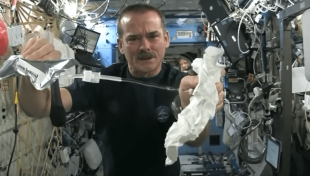A back-to-back failure occurred as the 8th test flight of SpaceX’s starship ran into critical problems and eventually blasted after 8 minutes of launch. There were huge roars of celebration and success from an enthusiastic team for a successful takeoff while it was broadcast Live. The ship was safely separated and went into space, after which the super booster that propels the ship out to space successfully returned to its Texas tower.
There were happy claps and screams at the sight of Booster clinging back to its tower. After only a few minutes, the ship spiraled out of control. Engineers lost control of multiple engines, followed by a gigantic blast. The debris started coming back like a shower of meteoroids and shooting stars. Then, the Federal Aviation Administration had to take quick action to reduce the number of flights in major Florida airports.

The Shower of Shooting Stars, Posted by OPTeemyst. It was the second failure in a row, as the seventh test flight met the same fate. The FAA immediately asked for a mishap investigation, and they sprang into action, halting and diverting flights to avoid any accidents due to debris falling from space. SpaceX communications manager Dan Huot said during the broadcast,
“We just saw some engines go out. It looks like we are losing attitude control of the ship.” Later, he mentioned that “at this point, we have lost contact with the ship.”
The ship exploded over the skies of the Bahamas and the Dominican Republic, and SpaceX had to post an immediate message on X that the vehicle experienced a rapid unscheduled disassembly and contact was lost. They are reviewing the data from this flight to understand the causes behind it. Given all that went wrong, SpaceX is an organization that never sits back, as the next test flight might already be on the cards.
SpaceX has shared the complete launch video on their official site with explanations and experience. There were 6 Raptor engines in the ship, and they stopped responding one by one until a sonic boom was heard. Elon Musk has been caught in many controversies over the past few days, including losing a lawsuit against OpenAI for stopping it from becoming a for-profit entity. This is an additional shock after the 7th flight broke down during its January 16th, 2025 test run.
During this 7th test flight, engines experienced premature shutdowns and a complete loss of control. Roughly two to three minutes later, the vehicle disintegrated over the Turks and Caicos Islands, though no injuries were reported. That incident also resulted in airspace closures for over an hour, and the FAA had to call for a mishap investigation. After 7th test flight, the booster successfully returned to its Launchpad. The SpaceX team can celebrate and can again stay hopeful and proud for the 3rd booster return as well during the 8th test.
Scores of appreciation and public sentiments were expressed on the 8th test flight, and people praised the SpaceX team’s positivity and struggles.

These tests are part of SpaceX’s mission of starting commercial flights into space, and SpaceX will continue to send the dummy versions of its Starlink satellites. They posted an investigation for their 7th test flight and changed several things to fix the previous issues, including improvements to the fuel system and the propellant. The company has always stayed very transparent in sharing the details of all its test flights and the glitches caught at any stage of the tests.
The 8 Starlink Flights’ Tests and Their Outcomes
| Test # | Date | Launch Outcome | Booster Landing | Ship Landing | Problems | Positives |
|---|---|---|---|---|---|---|
| Test 1 | April 20, 2023 | Failure | Failure | Precluded | Engine Failures within 4 min. | Most powerful, heaviest rocket ever flown. Reached 39 km height. |
| Test 2 | Nov 18, 2023 | Failure | Failure (Ocean) | Precluded | Leak in aft section during liquid oxygen venting, causing a combustion event that interrupted communication between the craft’s flight computers, leading to full engine shutdown. | Reached 150 km altitude. Powerful show of all 33 Raptors working and a successful hot stage separation. |
| Test 3 | March 14, 2023 | Success | Failure (Ocean) | Failure (Ocean) | Booster successfully propelled the spacecraft to staging, with 13 engines successfully ignited for a boostback burn, though 6 engines failed a few seconds before the end of the burn. | Reached 462 meters in altitude and seven minutes into the mission. All Raptor engines started successfully and powered the vehicle to its expected orbit, becoming the first Starship to complete its full-duration ascent burn. |
| Test 4 | June 6, 2024 | Success | Controlled (Ocean) | Controlled (Ocean) | Only one engine lost shortly after liftoff. | Mission lasted for 1 hour and 6 minutes with a soft landing in the Indian Ocean. Executed first flip maneuver. |
| Test 5 | Oct 13, 2024 | Success | Success (OLP A) | Controlled (Ocean) | The Booster RETURNED to LAUNCH Site. The greatest success ever achieved. Successful hot-staging separation, igniting its six Raptor engines and completing ascent into outer space. | |
| Test 6 | Nov 19, 2024 | Success | Controlled (Ocean) | Controlled (Ocean) | Second attempt at booster recovery. The ship completed in-space engine relight test and re-entered, splashing down in the Indian Ocean during daylight for the first time for any Starship. | |
| Test 7 | Jan 16, 2025 | Failure | Success (OLP A) | Precluded | Engines experienced premature shutdowns due to a propellant leak larger than the Ship’s systems could handle, followed by a total loss of telemetry. Vehicle exploded within 3 minutes. | Booster successfully returned to its launch pad. |
| Test 8 | Failure | Success (OLP A) | Precluded | Engines lost after 8 min into the space. | Booster successfully returned to its launch pad. |
Elon Musk is a man on a mission. He is spending his energy and resources on these impactful technological developments. He has succeeded in many of his previous endeavors, and he has the guts to try one more time.






Administrator